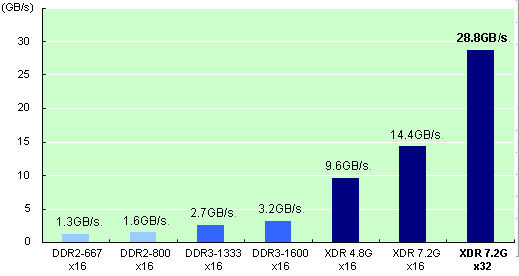Tuesday, January 20th 2009
Elpida Introduces Industry's First x32-bit 1-Gigabit XDR DRAM
Elpida Memory (Elpida), Japan's leading global supplier of Dynamic Random Access Memory (DRAM), today introduced the industry's first 1-Gigabit XDR DRAM based on a x32-bit configuration. The new XDR product features the industry's fastest ultra-high speed of 7.2GHz, which is faster than any GDDR5 memory chip, and provides a data transfer rate of 28.8 Gigabytes per second with a single device, making it an ideal choice for such high-bandwidth, high-performance full HD-capable applications as game consoles, digital televisions and Blu-ray disc recorders.
"Today's consumer electronics require both high performance and superior power efficiency," said Sharon Holt, senior vice president, Licensing and Marketing at Rambus. "Elpida's leadership with the award-winning XDR memory architecture makes possible a range of great products for consumers to enjoy."
The XDR device is manufactured using Elpida's 65nm process technology and utilizes a 1.5V low voltage operation and an x32-bit interface. It provides a one-chip solution that, compared with two x16-bit configuration 512 Megabit XDR DRAMs, consumes 35-40% less power and requires less space.
"In today's era of digital convergence many existing digital consumer electronic appliances are connecting to the Internet and the use of high compression codecs like H.264/AVC is spreading. This means there is now even more demand for greater bandwidth and higher density memory," said Yoshitaka Kinoshita, Elpida Memory's executive officer in charge of the Mobile & Digital Consumer Division. "Our newly developed 1-Gigabit XDR provides incredibly high bandwidth with lower operating power to meet the systems needs of our customers. Elpida will continue to focus on reducing the power consumption of XDR DRAMs, which we believe can also lead to tremendous application potential in portable devices."
Sample shipments of the new XDR have already started and mass production is scheduled to begin in April 2009.
As a top supplier of XDR DRAM, Elpida continues to specialize in developing high-performance, low-power XDR products.
New Product Features

DRAM Bandwidth

Source:
Elpida
"Today's consumer electronics require both high performance and superior power efficiency," said Sharon Holt, senior vice president, Licensing and Marketing at Rambus. "Elpida's leadership with the award-winning XDR memory architecture makes possible a range of great products for consumers to enjoy."
The XDR device is manufactured using Elpida's 65nm process technology and utilizes a 1.5V low voltage operation and an x32-bit interface. It provides a one-chip solution that, compared with two x16-bit configuration 512 Megabit XDR DRAMs, consumes 35-40% less power and requires less space.
"In today's era of digital convergence many existing digital consumer electronic appliances are connecting to the Internet and the use of high compression codecs like H.264/AVC is spreading. This means there is now even more demand for greater bandwidth and higher density memory," said Yoshitaka Kinoshita, Elpida Memory's executive officer in charge of the Mobile & Digital Consumer Division. "Our newly developed 1-Gigabit XDR provides incredibly high bandwidth with lower operating power to meet the systems needs of our customers. Elpida will continue to focus on reducing the power consumption of XDR DRAMs, which we believe can also lead to tremendous application potential in portable devices."
Sample shipments of the new XDR have already started and mass production is scheduled to begin in April 2009.
As a top supplier of XDR DRAM, Elpida continues to specialize in developing high-performance, low-power XDR products.
New Product Features

DRAM Bandwidth

8 Comments on Elpida Introduces Industry's First x32-bit 1-Gigabit XDR DRAM
But I'm sure SSD's will catch on before then.
For the iliterates on the matter, a memristor is a passive fundamental circuit element (like resistors and capacitors are) the size of a transistor (potentially, not yet) that can contain one bit of information. It's non volatile so it can contain the info "forever" and because it's a circuit element, it can potentially work at speeds close to the transistors, many times faster than RAM and even caches. Also because it's a single circuit element that could replace memory cells (made of many transistors, resistors...) it will allow for much greater densities never seen before. Think of chips with TBytes of cache memory that don't need any other external storage for the OS and the programs you use most...